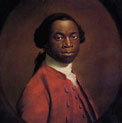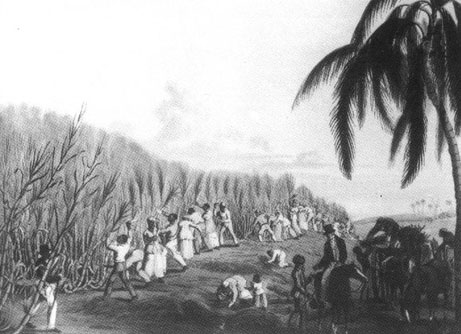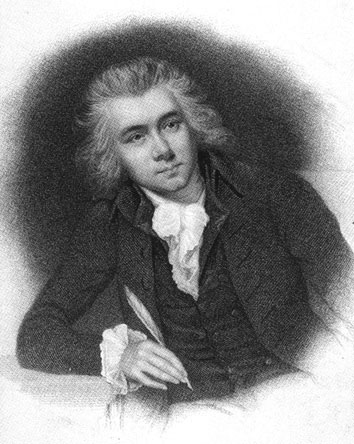Co-editors: Seán Mac Mathúna • John Heathcote
Consulting editor: Themistocles Hoetis
Field Correspondent: Allen Houglande-mail: thefantompowa@fantompowa.org
Olaudah
Equiano or Gustavas Vassa, the African slave - a short
biography
I have always wondered why the
rich and privileged had built their houses overlooking
Blackheath common in the UK capital, London. A little bit of
research came up with the answer: It was because of it's
closeness to London's docks with it's connections to the
sugar trade, which for most of it's history, depended on the
slave labour of Africans on the plantations in the
Caribbean. London merchants were the main businessmen to
profit from the sugar trade, handling some 75% of the sugar
imported according to Joan Anim-Addo, writing in Longest
Journey: A History of Black Lewisham.(1) Many slave
traders and sugar merchants lived in comfortable mansions
that were built around Blackheath common. It is strange that
there is no official acknowledgment of this in the history
of Deptford and Greenwich. A number of local residents of
the Lewisham area profited directly from the slave trade and
it's business connections with the Caribbean. One such man
was John Thomson, son of Maurice Thomson, a resident of the
Manor House in Lee for at least three years after the death
of his father. Maurice Thomson had been appointed a
commissioner in the Navy and Customs in 1654. His wife,
Francis Annesley also came from a family closely involved
with trade in the West Indies. Another resident of the Manor
House at Lee with connections to slavery was William Coleman
who lived their around 1750. Baring Road in South East
London is named after the slave trader Francis Baring. He is
said to have his first money trading in slaves when he was
just 16, indicating his family's immense wealth and business
connections with the West Indies. It was this family that
was later to develop their business into the present day
Barings Bank, that was destroyed by the the trading of Nick
Leeson in 1995. Speculation in the slave trade helped made
the bank and speculation on the international money markets
destroyed it. At least 20 merchants who lived
around the edge of Blackheath in the 18th century were
closely involved in the slave trade. These
include: We should not forget the
shipbuilders of Deptford who made many of the ships that
were involved in the slave trade and England's imperialist
adventures abroad. One family appeared to have dominated
Kentish shipbuilding along the Thames - the Pett family who
had been master shipbuilders since the time of Edward VI
(reigned 1461-1483). The woodland that provided much of
trees for this shipbuilding was named after them: Pett's
Wood near Chislehurst in Kent. The Pett family had been
involved in building ships for Drake's expedition to the
Caribbean in 1595 according to Jess Steele writing in
Turning the Tide. (2). There are four statues on the
front of Deptford's old town hall in New Cross Road. Three
of them are connected with slavery in the West Indies: Sir
Walter Raleigh, Sir Francis Drake and Oliver Cromwell. In
1652, Cromwell had been a regular visitor to Deptford to
oversee the building of two ships The James and The Diamond
- built solely it seems, for expeditions to the Caribbean
aimed at displacing Spanish power in the region. Maurice
Thomson, a resident of the Manor House at Lee mentioned
earlier, was said to have been a personal friend of
Cromwell's and involved in these expeditions. They were part
of a network of businessmen interested in the vast wealth
that could be derived from the sugar/slave trade. Under Cromwell, the English
Navy seized Jamaica from the Spanish in 1655 and established
Barbados as a centre for the trading in slaves. The Spanish
had wiped out the original inhabitants of the island, the
Arawaks (who gave there name Xaimaca to the island),
and they had replaced them with slaves brought from Africa -
a practice eagerly pursued by traders from London which
brought them vast profits. By 1664, Jamaica had been
established as a major sugar producing island. After the restoration of King
Charles II in 1660, a new slave-trading company was set up
called the Royal Adventurers into Africa. The company had
the support of Charles, and it is a fact that the British
royals were first members of a European royal family to
visit West Africa - in this case, of course, on slave
business - when Prince Rupert, the brother of Charles
visited the region to inquire about further business. Rupert
was the President of the company, and the King's sister,
Princess Henrietta also had a share, as did the Queen
Mother, and another famous resident of South London, Samuel
Pepys, who has a road and school named after him in South
London. Most of the business at first
done by this company was in Guinea - hence the origin of the
currency still known in the UK as a "Guinea" - in fact the
use of this coin - with all its links to the history of
slavery, carried on in the UK until the abolition of the old
shilling in 1967. When the company was wound up in 1672, it
was succeeded by the Royal African Company (RAC), with gold
and slavery as it's main business. The Governor and largest
shareholder was James, Duke of York, and other prominent
shareholders included over the years, 15 lord mayors of
London, and 25 sheriffs of London, including the so-called
"philosopher of liberty", John Locke, who had a total of
£600 invested in this company which sold human beings
as mere objects of property. Between 1672 and 1689, the
company exported just under 90,000 slaves into the West
Indies. A further 75,000 slaves were sent to British North
America, and sold onto plantations in the 13 colonies,
between 1673 and 1725, according to Hugh Thomas, writing in
his excellent book The Slave Trade: The History of the
Atlantic Slave Trade 1440-1870 (3). The hidden history of South
London's close relationship to the Slave trade is thus still
evident with street names, pub names and statues in
Deptford, New Cross and Lewisham. Whilst l am not suggesting
that the statues be removed from the front of Deptford's old
town hall, certain street names could be changed - instead
of Baring Road for example, it could be Olaudah
Equiano Road or even
William Wilberforce Street etc. A statue could be put up to
commemorate the arrival of the first slaves in Deptford in
1535, and the local history of the area rewritten to include
this shameful chapter in London's history. REFERENCES 1 Longest Journey: A History
of Black Lewisham, ibid, pp42-45 © 1998


Enriched
slaving merchants used their profits to buy land and
titles, symbols of status and power Joan
Anim-Addo in Longest Journey: A History of Black
Lewisham.

William
Wilberforce who led the parliamentary campaign
to abolish slavery in Britain from 1789 to
1807
2 Turning the Tide, p 22. Jess Steele, Deptford,
London, UK, 1993
3 The Slave Trade: The History of the Atlantic Slave
Trade 1440-1870, Hugh Thomas, Picador, London, UK,
1997.